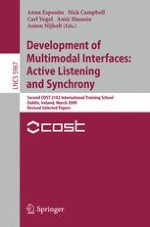This volume brings together, through a peer-revision process, the advanced research results obtained by the European COST Action 2102: Cross-Modal Analysis of Verbal and Nonverbal Communication, primarily discussed for the first time at the Second COST 2102 International Training School on “Development of Multimodal Int- faces: Active Listening and Synchrony” held in Dublin, Ireland, March 23–27 2009. The school was sponsored by COST (European Cooperation in the Field of Sci- tific and Technical Research, www.cost.esf.org ) in the domain of Information and Communication Technologies (ICT) for disseminating the advances of the research activities developed within the COST Action 2102: “Cross-Modal Analysis of Verbal and Nonverbal Communication” (cost2102.cs.stir.ac.uk) COST Action 2102 in its third year of life brought together about 60 European and 6 overseas scientific laboratories whose aim is to develop interactive dialogue systems and intelligent virtual avatars graphically embodied in a 2D and/or 3D interactive virtual world, capable of interacting intelligently with the environment, other avatars, and particularly with human users.
